These Stardew Valley tips will help no end with a game jam-packed with tasks for you to complete on a daily basis. There are certain things you should do to get the ball rolling and the goats on your farm bleating that little bit easier. That’s where our Stardew Valley tips come in. It can be a little overwhelming working out what’s the best plan of action to get the most out of Stardew Valley. Do you tend to your crops first? Check on your animals? Chat to all the villagers? Head into the mines? If you play smart, you’re in for a treat. Thankfully, we’ve put together some of our top tips, not only on how to make money quickly but how to get the most out of your first year in the game too.
Stardew Valley cheats | Stardew Valley co-op | Stardew Valley fish | Stardew Valley gifts | Stardew Valley Prismatic Shards | Stardew Valley Golden Walnuts | Stardew Valley mods
For those not in the know, Stardew Valley is a farming sim not too dissimilar to the likes of Harvest Moon, where you tend your farm, raise animals and crops, and also make a bit of a name for yourself in the community. Below it’s cutesy exterior lies a game with a ton of mechanics, things to do and a good level of impenetrability.
At the start, things will seem slow as you get to grips with everything that Stardew has to offer, but we’re here with a bunch of tips to make the simple life a little simpler.
How to make money quickly in Stardew Valley
When you first start out in Stardew Valley, you’ll be given 500g or 500 pieces of shiny gold. And although that might sound like a lot, you’ll quickly burn through that and if you’re anything like me, you’ll be left scratching your head as to how to make more without waiting for days for your harvest to grow.
Well, there’s technically no quick way to rake in the gold in Stardew Valley, but there are a few things that you can do to usher the cash into your account a little faster.
1. Invest in crops as soon as possible

Your little farming starter pack contains 15 turnip seeds, which you’ll want to plant straight away. To do this, simply take your new hoe and till 15 little patches of soil in which to plant them. Don’t forget to give them a water with the can, which you can fill using the water around the farm, otherwise they’re never going to grow.
After that, you’ll want to invest your money carefully in more seeds, which you can get from Pierre’s shop in town, among other places. But you’ll want to be careful about what crops you buy and when. Initially, we recommend investing in two or three Cauliflower seeds as they cost 80g, but the finished crop is worth much more. Also pick up some more turnip seeds and some potatoes. What’s great about taters is that they not only sell for 80g a piece, but there’s a chance they’ll yield another potato when you harvest them, meaning you get more spud for your dollar. Plus, they only take six days to grow, meaning if you pair them with the four day growers that are the turnips, you’ll soon have enough dosh to invest in a serious cauliflower crop.
2. Learn which are the most valuable crops per season

The cauliflowers might be the hit thing for spring, but you’ll want to know which crops earn you the most money for every season if you’re going to make a killing in Stardew Valley. Take a look at the minimum price you’ll get for each crop in each season in the first year (depending on the quality of your final produce) and how to get them. Plus, bear in mind that things like green beans, hot peppers and other crops will yield more than one crop per harvest, but it’ll tell you that when you buy the seeds.
Another trick is to save up for the Greenhouse, which will let you grow crops regardless of what season you’re in, including during the winter.
Spring:
- Parsnips - 35g or more (Buy seeds at Pierre's General Store)
- Potatoes - 80g or more (Buy seeds at Pierre's General Store)
- Cauliflowers - 190g (Buy seeds at Pierre's General Store)
- Green Beans - 40g or more (Buy seeds at Pierre's General Store)
- Kale - 110g or more (Buy seeds at Pierre's General Store)
- Strawberries - 500g (Obtain seeds during Egg Festival on Spring 13)
Summer:
- Hops - 25g or more (Buy seeds at Pierre's General Store)
- Blueberries - 50g or more (Buy seeds at Pierre's General Store)
- Hot Peppers - 40g or more (Buy seeds at Pierre's General Store)
- Radishes - 90g or more (Buy seeds at Pierre's General Store)
- Wheat - 25g or more (Buy seeds at Pierre's General Store)
- Melons - 250g or more (Buy seeds at Pierre's General Store)
- Corn - 50g or more (Buy seeds at Pierre's General Store)
- Tomatoes - 60g or more (Buy seeds at Pierre's General Store)
Autumn:
- Cranberries - 75g or more (Buy seeds at Pierre's General Store)
- Pumpkins - 320g or more (Buy seeds at Pierre's General Store)
- Grapes - 80g or more (Buy seeds at Pierre's General Store)
- Artichokes - 160g or more (Buy seeds at Pierre's General Store)
- Bok Choy - 80g or more (Buy seeds at Pierre's General Store)
- Eggplant - 60g or more (Buy seeds at Pierre's General Store)
- Yam - 160g or more (Buy seeds at Pierre's General Store)
- Amaranth - 150g or more (Buy seeds at Pierre's General Store)
- Rare Seeds - 3000g or more (Buy seeds from the Gypsy Wagon)
3. It’s hip to be square
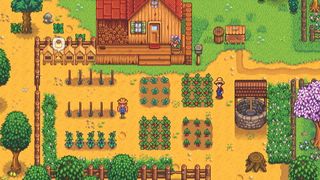
When you’re planting be mindful of where you’re dropping your seeds as there’s a trick to potentially making a few extra bob just by being a little more careful about your seed placement. When you’re planting cauliflower, melons, and Pumpkins, try and plant them in 3x3 squares. Doing this gives you a slim chance of growing a giant crop, which will take up all nine squares of soil. You won’t know whether it’s worked until harvest day, but it’s worth a shot right?
4. Don’t worry about animals too soon

If you want to really streamline your money-making expeditions, you’ll want to ignore your desires to invest in livestock until you’ve got far more gold rattling in your pocket. I made the mistake of falling for the idea of being surrounded by farm animals and spent as much money as I could building homes for them, feeding them and buying them new friends.
However, when winter rolls around, if you play like I did you’re going to get stuck, because the game doesn’t regenerate enough grass to feed your growing menagerie, meaning you have no choice but to buy hay from Marnie to get you through the season. And with hay priced at 50g a pop, your animals will soon drain your hard-earned funds.
It is a risk you might be willing to take though, seeing as the Community Centre does need quite a few animal-based offerings.
5. Prioritise wood
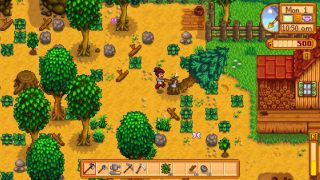
Once you’ve planted and watered your crops, it’s worth focusing your energy on chopping down trees. You’ll want to start stockpiling wood, because it’s a key resource for unlocking new buildings and items on your farm. Try not to sell it unless you’re super desperate for cash, because you’ll quickly be able to craft incredibly useful items like storage chests.
6. Unlock the beach bridge first

Once you’ve got 300 wood, you’ll also want to repair the bridge to the left hand side of the beach. Doing so will give you access to the Tidal Pools, which is where valuable items like coral, sea urchins and other shells will pop up daily. You can chuck these in your shipping box (more on which in a mo), or sell them directly to the fisherman, Willy, at his shop on the pier.
7. Mine the mines for all they’ve got

On the fifth day of Spring in your first year, you’ll get a letter that informs you all the stones blocking your access to the mines northeast of the Carpenter’s Shop and just west of the Adventurer’s Guild have been magically removed. This just happens to be a gold mine, in that you can forage in them to get yourself a load of special items that can earn you serious cash - and literal gold too.
The mines consist of 120 unique levels, with a save point accessed after every five. And the deeper you go, the better stuff you’ll get. Use your hoe to dig in the dirt and your pickaxe to smash rocks in order to find items but also the ladder to the next level. You’ll also be given a sword to fend off the beasties looking to drain your health. Using your sword thankfully doesn’t drain your energy, but I’d recommend taking a few snacks with you.
8. Fish until you flop
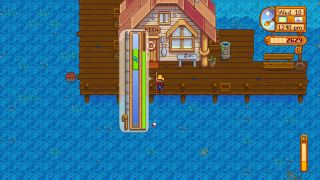
You’ll want that extra energy to put into time spent fishing. Early on in the game you’ll be given a fishing rod from Willy and you’ll quickly discover that if you put some time into it, it can become a very lucrative hobby indeed.
The problem is that it can be tricky to master at first, but there’s definitely a knack to it that the game really doesn’t explain. Head to a body of water and equip your rod. Then hold down the action button and don’t let go of the button until your cursor hits the top of the meter. That means your line will be cast as far as it’ll go and you’ll have a better chance of catching a higher value fish that are easier to catch (although you’ll catch different fish depending on where your line lands, so once you’ve mastered fishing it’s good to experiment). Wait for a fish to bite and quickly tap the action button as soon as the exclamation point appears.
Now comes the tricky bit, because you’ll have to hold the action button to keep your green border around the fish long enough for the catch bar to fill up completely. The fish can move about quite a lot and if your bar depletes it’ll escape. The more you fish the better your skill becomes, and the bigger your green window will be, making it easier to nab those pesky pesce.
Once you’ve figured all that out, fishing becomes a brilliant way to earn some g, fast. Look out for bubbling spots in the water as fish tend to bite more quickly there and be of higher value.
As soon as you can, you’ll want to buy the fibreglass rod from Willy too (available once you reach fishing level two), as it’ll allow you to add bait to your line. He also sells crab pots that you can buy once you reach fishing level three, which you can bait and leave to do their thang. Just remember to come back daily to check for catch and restock the bait and you’ll have another little earner on your hands.
Tips for making the most out of Year One in Stardew Valley
Of course, it's not all about making money in Stardew Valley, it's about making your farm whatever you want it to be. Arable paradise, animal haven, or a mix of the two - it's up to you. But you could also choose to ignore all that and become a professional miner or fisherman.
But we recommend dabbling in a little bit of everything in Year One, and here's how to make the most of it.
1. Don’t cry over lost onions

And the best snacks come for free. The world of Stardew Valley has plenty of free things you can forage just by walking around the town and its surroundings. Watch out for leeks, horseradishes, dandelions and daffodils growing the wild. Dandelions and leeks restore energy and health when eaten, while daffodils can be sold for 30g a pop. Wild horseradishes are worth 50g each, and only restore a small amount of health and energy, so are better sold that used as mining snacks.
And every Spring, you’ll need to make a daily detour to the south-east corner of the map where there’s a little farm that spawns spring onions every day. The amount varies day to day but they’re a fantastic snack that restores a nice chunk of energy. They only sell for 8g, but when you can use the energy to get items that sell for more, they’re well worth the walk.
2. Always watch TV before bed
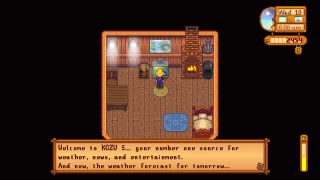
This might seem a little too close to real life, but make sure you turn on the TV and flick through the channels before you crawl into bed at the end of every day. The weather channel is perfect for checking what the weather is going to be like the next day, because if it’s going to rain, you’ll be able to plan to go down the mines instead and won’t have to waste your time in the fields - so pack your bag accordingly.
There’s also two other channels that you can watch - Survival and Cooking. The Survival channel will give you handy tips and the occasional foraging advice, while the Queen of Sauce over on the cooking channel will teach you recipes that increase your health and energy.
The fortune teller channel is also worth a quick watch, as she’ll tell you what your luck is going to be like. On high luck days, go to the mines and fish more as you’ll have a better chance of finding rare items.
3. Your shipping box is a great asset

Although you can sell your crops, fish and other collected items to the folks in town, you can also just chuck it in the shipping box that’s right next to your house. Overnight, some mysterious soul will buy all your stuff, which is incredibly handy if you want to spend your time the next day doing other things than walking between different stores to sell your wares.
4. Upgrade your bag as soon as you can
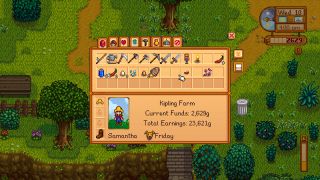
You might be reluctant to spend all your hard earned cash, but if you’re going to make serious dosh in Stardew you’re going to need bigger pockets. Pierre sells a bag that increases your personal inventory slots from 12 to 24, which is perfect for storing all those things that you collect and want to sell. It might feel like a lot of cash to spend at the start, but 12 slots fill up super fast.
5. The Community Centre is key to true progression
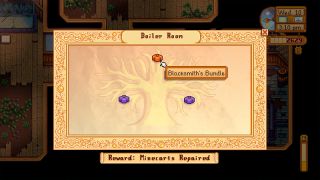
And speaking of the Community Centre, you’ll want to make this a primary focus as you play in Stardew Valley. It’s not particularly linked to making lots of money, but it is crucial to unlocking the full potential of the world of Stardew. Several major features are actually locked until you complete one of the Community Centre’s six sections. The Boiler Room is particularly useful as it’ll let you fast travel across the town. There’s also bridge repair options and bus repairs that you’ll want to focus on if you want to see everything that Stardew has to offer.

